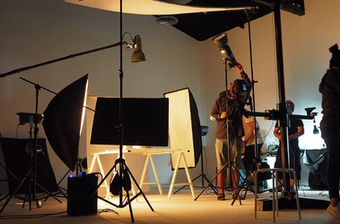
Going Live:
How to turn Your Healthcare or Pharma Office into a Pro Broadcast Studio
If you work in life-sciences, you already know that every second counts—whether you’re explaining a new therapy to a global medical team or hosting a Key Opinion Leader (KOL) round-table for investors and press. Yet too many organisations still rely on ad-hoc webcams and conference calls that fail to capture the energy of an in-person event. The good news? With today’s affordable cameras, lights and software, you can convert a spare meeting room into a polished broadcast studio and start streaming town-halls, advisory boards and training sessions that look and sound as professional as the science you deliver.
Below you’ll find a step-by-step, jargon-free roadmap that covers only the essentials—perfect for teams who want to get up and running fast, stay compliant, and keep budgets sensible.
1. Understand Your Broadcast Goals
List the events you truly need to stream.
Typical scenarios in healthcare and pharma include:
- Global town-halls — executive updates to thousands of distributed employees.
- KOL panels or fireside chats — credibility-building sessions with external experts.
- Virtual investigator meetings (VIMs) or clinical-training modules —regulatory or protocol briefings for sites.
For each use case, jot down:
| Question | Why It Matters |
|---|---|
| Who is the primary audience? | Determines language, depth of detail and any regulated content controls. |
| Live, on-demand or both? | Dictates your recording pipeline and storage needs. |
| Typical attendance size? | Influences bandwidth, CDN costs and chat/moderation workflow. |
| Public or internal only? | Triggers privacy (IPHA/GDPR) and security requirements. |
A quick exercise like this keeps your shopping list realistic and helps you articulate ROI when leadership asks why you need new gear. In pharma, virtual town-halls have proven crucial for maintaining engagement across time-zones and tight compliance windows (globalmeet.com).
2. Essential Equipment Checklist (Basics Only)
Pro tip: Buy gear that your internal IT/AV team can support; exotic cinema cameras that no one knows how to operate will sit on shelves.
2.1 Cameras
- PTZ (Pan-Tilt-Zoom) networks cameras: Modern PTZs deliver 1080p–4K images, can be driven from a simple joystick or even an iPad, and let you frame multiple speakers without hiring a camera operator (bhphotovideo.com).
- One fixed “safety” cam: A locked-off wide shot that covers the whole stage acts as a fallback if someone bumps the PTZ.
- HDMI/SDI capture cards: Convert camera signals into USB or NDI® so your computer sees them as webcams. Brands such as Magewell and AJA dominate here.
2.2 Lighting
Even the best camera will struggle if your presenters sit in shadows. Start with a three-point LED kit (key, fill, back light) and add a soft-panel for flattering skin tones. LED panels that let you dial in colour temperature (3200–5600 K) make it easy to match ambient office lighting. For small spaces, a single ring-light or compact key-light mounted above the lens can work but ensure its bright enough (1000+ lux at 1 m) and flicker-free. New 2025 guidance emphasises diffused, front-facing light for video-conference scenarios (obsbot.com).
2.3 Audio
- Wireless lavaliers (clip-on mics) keep hands free and clothing-noise minimal.
- Boundary or shotgun mics on the desk catch audience Q&A.
- Audio interface / small mixer gives you gain control, simple EQ and a mute button. Remember that your viewers will forgive slightly soft video but will abandon a stream with crackly sound.

2.4 Switching & Encoding
You have two main approaches:
| Option | Pros | Cons |
|---|---|---|
| Software-only (OBS, Streamlabs, Wirecast) | Low-cost or free; integrates with Teams, Zoom, YouTube; runs on any modern PC. | Steeper learning curve; needs a powerful GPU/CPU. |
| Hardware switcher (e.g., ATEM Mini, vMix GO) | Tactile buttons; built-in multiview; lower PC load. | Extra upfront cost. |
A free platform such as OBS Studio is ideal for pilots, while vMix offers advanced graphics and ISO-recording for larger events. Recent 2025 comparisons show vMix’s premium price balanced by more built-in virtual-set options, whereas OBS remains the go-to for cost-sensitive teams (eventlive.pro).
Compliance note: Whatever software you choose, ensure it supports encrypted RTMPS or SRT and user-access controls if you handle patient data or discuss confidential trial results. Vimeo, for example, publishes HIPAA-aware configuration guides (vimeo.com).
2.5 Network & Power
- Hard-wire Ethernet whenever possible. Wi-Fi is a last resort. Aim for 2× your expected upload bitrate.
- Uninterruptible Power Supply (UPS) keeps cameras and encoders alive through brief outages.
- Secondary bonded-cellular encoder (e.g., LiveU Solo) is optional insurance for mission-critical broadcasts. Vendors specialising in 5G bonding encoders market heavily to corporate town-halls (skywirebroadcast.com).
3. Transforming a Meeting Room into a Studio
| Step | Action | Why It Matters |
|---|---|---|
| Pick a quiet, rectangular room | Avoid walls of glass or HVAC rumble. | Fewer reflections and external noise. |
| Treat the acoustics | Foam tiles, heavy curtains, carpets, even bookshelves reduce echo. Guides recommend starting with doors/windows first (soundproofwise.com). | Clearer audio, less fatigue for viewers. |
| Design your backdrop | Branded step-and-repeat, printed SEG fabric or a neutral colour with subtle uplighting. | Consistent corporate identity and fewer on-screen distractions. |
| Plan the layout | Leave 1.5–2 m between subject and background to help cameras create depth-of-field. | Makes “talking-head” shots less flat. |
| Cable management | Velcro ties, floor runners, labelled ports. | Safety and faster troubleshooting. |
| Lighting grid or stands | Mount LED panels overhead or on C-stands outside the frame. | Frees floor space and ensures repeatable placement. |
| Control desk | A sturdy table for laptop, mixer, stream deck and confidence monitor. | Keeps the operator out of shot but within line-of-sight to presenters. |
Soundproofing hacks on a budget: swap hollow-core doors for solid, add door sweeps, and hang acoustic curtains—simple upgrades borrowed from home-studio playbooks (bhg.com).
4. Running Broadcast-Quality Events
4.1 Branding & Graphics
Use lower-third templates that match your corporate palette. Display speaker names, product names (but not unapproved claims), and real-time polls. Save these assets in your switcher software so that future events are “plug-and-play.”
4.2 Dry-Runs and Technical Rehearsals
Every event deserves at least one full rehearsal with presenters on-site or joining remotely. Industry testing specialists note that load-testing a live stream in advance can prevent CDN or API failures that only appear under high traffic (testlio.com). A good run-through covers:
- Network stress test (stream privately and monitor dropped frames).
- Audio checks (each mic, remote guest channels, backup recordings).
- Graphics timing (slides, video roll-ins, polls).
- Emergency scenarios (encoder crash, internet loss, remote speaker drop).
RingCentral’s 2025 virtual-event guidelines remind planners that rehearsals build presenter confidence and surface compatibility issues—e.g., mismatched slide ratios—long before showtime (ringcentral.com).

4.3 Staff Training Basics
- Camera operators (even PTZ) learn safe preset positions and white-balance shortcuts.
- Audio tech knows how to EQ out HVAC hum and record multitrack stems.
- Stream producer cues graphics, pushes lower thirds and manages chat.
- Compliance reviewer monitors live Q&A for off-label discussions.
A three-person crew can comfortably run most internal town-halls; for public webcasts add moderation and tech-support staff.
4.4 Post-Event Workflow
- Record locally and in-cloud. Always have a high-bit-rate master for editing.
- Transcode for on-demand. Trim dead air, add chapter markers.
- Secure storage. Encrypt archives that contain proprietary data or PHI; many HIPAA-ready platforms automate this (vimeo.com).
- Analytics review. Measure viewer retention, hotspots and drop-off points to refine future formats.
5. Cost-Saving Shortcuts (Without Cutting Corners)
- Start with one PTZ plus a wide-angle webcam before scaling to multi-camera.
- Lease lighting kits for quarterly events instead of buying if utilisation is low.
- Repurpose existing meeting-room displays as confidence monitors.
- Use free NDI® Tools to move video signals over your existing Gigabit network, reducing cable spend.
- Bundle SaaS licences. Some enterprise video platforms include secure hosting, registration pages and analytics under a single contract—often cheaper than cobbling tools together.
In Conclusion
Setting up an in-house broadcast studio no longer requires a television-station budget or engineering degree. By focusing on a tight list of core components—PTZ camera, LED lighting, quality microphones and user-friendly switching software—you can deliver crystal-clear, compliant and engaging broadcasts directly from an ordinary office. The payoff is huge: faster knowledge-sharing, stronger KOL relationships and a workforce that feels connected no matter where they are in the world. Start small, iterate through regular rehearsals, and watch your communications mature from “good enough” to genuinely audience-worthy.
Contact Agency X today if you would like to discuss how we can help you set up an in house recording studio, our expert team would be delighted to help!
Sources
- Skywire Broadcast – Video Conferencing Solution for Corporate Events (skywirebroadcast.com)
- GlobalMeet – Virtual Town Halls for the Pharmaceutical Industry (globalmeet.com)
- B&H eXplora – Utilizing PTZ Cameras in Healthcare Facilities (bhphotovideo.com)
- OBSBOT – How to Set up the Best Lighting for Video Conferencing? (obsbot.com)
- SoundproofWise – 17 Effective Ways to Soundproof an Office (soundproofwise.com)
- Better Homes & Gardens – How to Soundproof a Room (bhg.com)
- Vimeo – HIPAA Considerations for Video Content (vimeo.com)
- EventLive – Streaming Software: OBS vs vMix – Which Tool Truly Connects Your Audience? (eventlive.pro)
- Testlio – Live Stream Testing Best Practices (testlio.com)
- RingCentral – Technical Setup and Rehearsal Tips for Virtual Events (ringcentral.com)
Contact one of our Events managers at Agency X today to discuss how we can help plan your upcoming Corporate Conference or Event.We'll be delighted to help!

